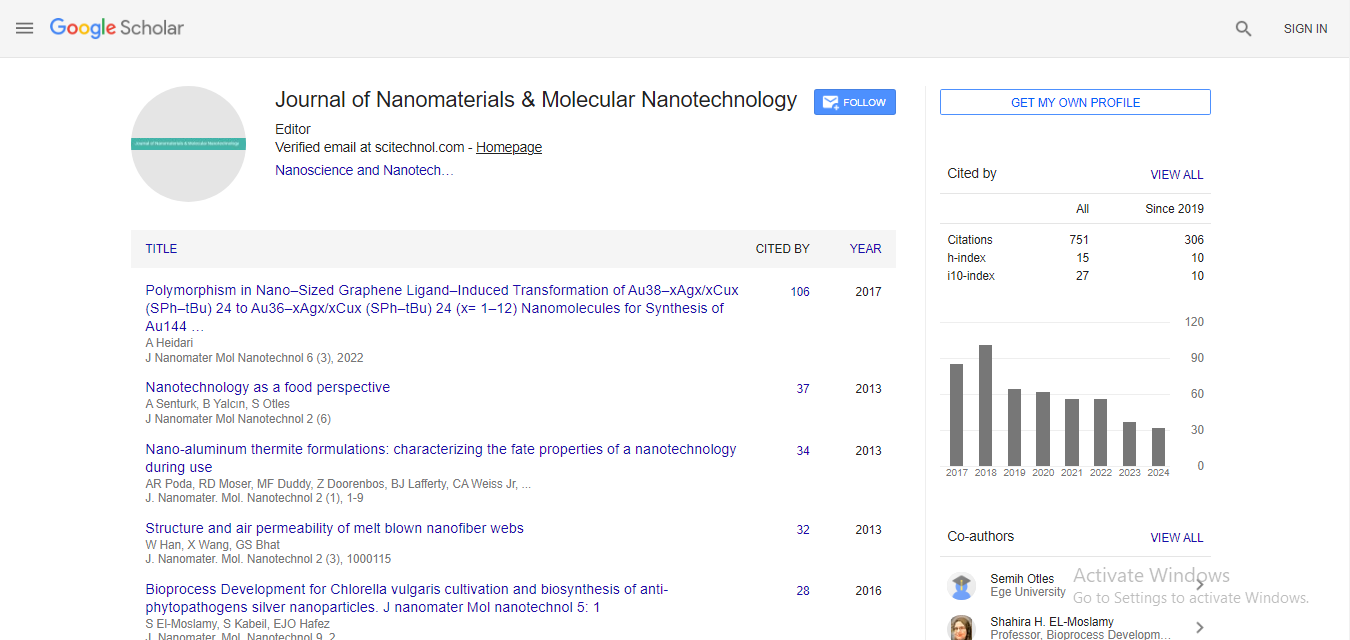Opinion Article, J Nanomater Mol Nanotechnol Vol: 13 Issue: 6
Innovations in Nanomaterials: Connection between Research and Industry
Aulia Reza*
1Department of Chemistry, Padjadjaran University, Sumedang, Indonesia
*Corresponding Author: Aulia Reza,
Department of Chemistry, Padjadjaran University, Sumedang, Indonesia
E-mail: li.re54@unpad.id
Received date: 22 November, 2024, Manuscript No. JNMN-24-156134;
Editor assigned date: 25 November, 2024, PreQC No. JNMN-24-156134 (PQ);
Reviewed date: 09 December, 2024, QC No. JNMN-24-156134;
Revised date: 16 December, 2024, Manuscript No. JNMN-24-156134 (R);
Published date: 24 December, 2024, DOI: 10.4172/2324-8777.1000440
Citation: Reza A (2024) Innovations in Nanomaterials: Connection between Research and Industry. J Nanomater Mol Nanotechnol 13:6.
Description
Nanomaterials, materials engineered at the nanoscale (1 nm-100 nm), have developed as a transformative force in modern science and technology. Their unique physical, chemical and mechanical properties make them suitable for diverse applications, ranging from medicine to energy, electronics and environmental remediation. Despite the substantial advancements in nanomaterial research, a significant gap exists between laboratory innovations and large-scale industrial implementation. This gives the current state of nanomaterials, highlights major innovations and identifies challenges and strategies for bridging the research-to-industry divide.
Recent advances in synthesis techniques have enabled precise control over the size, shape and properties of nanomaterials. Chemical Vapor Deposition (CVD) widely used for producing high-quality graphene and carbon nanotubes. Sol-gel processing allows the creation of nanoparticles with uniform size and morphology. These methods ensure scalability and reproducibility, two important factors for industrial adoption. Targeted drug delivery systems, nanocarriers functionalized with ligands or peptides for site-specific delivery. Functionalized nanomaterials with enhanced surface area and active sites for chemical reactions. Nano-engineered surfaces for detecting biological, chemical, or physical changes at an ultrasensitive level.
Combining two or more nanomaterials has led to hybrid systems that exhibit superior properties compared to their individual components. Graphene-metal oxide composites use in supercapacitors and energy storage devices. Nanocomposites in construction enhancing strength, durability and thermal insulation properties. Lipid nanoparticles, carbon nanotubes and polymeric nanoparticles enable targeted and controlled drug release. Quantum dots and magnetic nanoparticles improve imaging resolution in Magnetic Resonance Imaging (MRI), Computed Tomography (CT), and positron Emission Tomography (PET) scans. Silver nanoparticles are used in medical devices and hospital environments to prevent infections.
Water purification for nano-based filters, membranes and adsorbents efficiently remove heavy metals, dyes and pathogens. Air filtration functionalized for nanomaterials capture pollutants, VOCs and toxic gases. Nanoparticles such as zero-valent iron are employed to break down organic contaminants. Graphene-based materials enable wearable and foldable electronic devices. Ultra-sensitive sensors for detecting gases, pressure, temperature and biomolecules. Carbon nanotubes and 2D materials (e.g., MoS2) show potential to replace silicon in electronic devices. Many synthesis techniques remain expensive and energy-intensive, limiting large-scale production. The need for cost-effective, scalable manufacturing processes is important. The presence of impurities, structural defects and batch-to-batch variations reduces the reliability of nanomaterials in industrial applications. Standardized synthesis protocols are essential to ensure reproducibility. The toxicity and environmental impact of nanomaterials remain under scrutiny. Long-term studies are required to evaluate their effects on human health and ecosystems. Developing eco-friendly nanomaterials and green synthesis methods is a major step forward. The lack of clear regulations controling the use of nanomaterials creates uncertainty for industries. Establishing safety guidelines, testing protocols and certification standards can accelerate commercialization. Investing in technologies that enable the scalable, low-cost production of nanomaterials is essential. Innovations in chemical synthesis, automation and continuous-flow processes can reduce production barriers.
Developing biodegradable and environmentally friendly nanomaterials can address safety concerns and appeal to regulatory bodies and consumers. Green synthesis methods, such as using plant extracts or renewable resources, hold potential. Governments play a key role in encouraging the adoption of nanomaterials through funding, infrastructure development and the establishment of clear regulatory frameworks. Incentivizing research and industrial uptake can accelerate progress.
Conclusion
Nanomaterials hold immense potential to revolutionize industries through their unique and customizable properties. While significant strides have been made in research and development, challenges such as cost, scalability, safety and regulatory issues persist. Connecting between research and industry requires a multi-dimensional approach involving collaboration, technological innovations, sustainability and supportive policies. As the world moves toward a future driven by advanced materials and technologies, nanomaterials will play a central role in solving global challenges and unlocking new opportunities across sectors. By addressing existing barriers, we can ensure that these innovations make their way from laboratories to real-world applications, driving progress and creating a sustainable future.
 Spanish
Spanish  Chinese
Chinese  Russian
Russian  German
German  French
French  Japanese
Japanese  Portuguese
Portuguese  Hindi
Hindi 



